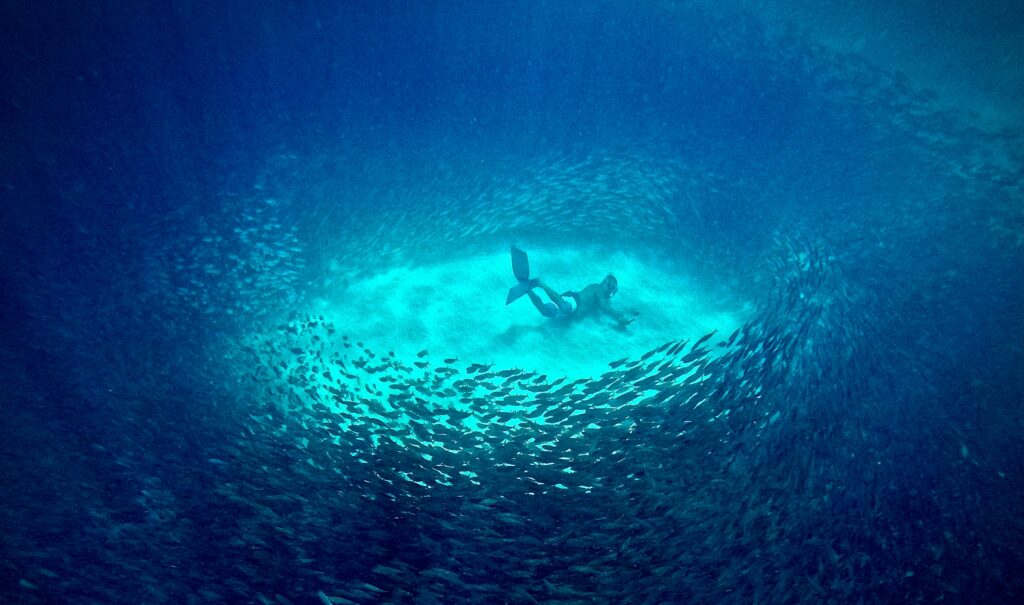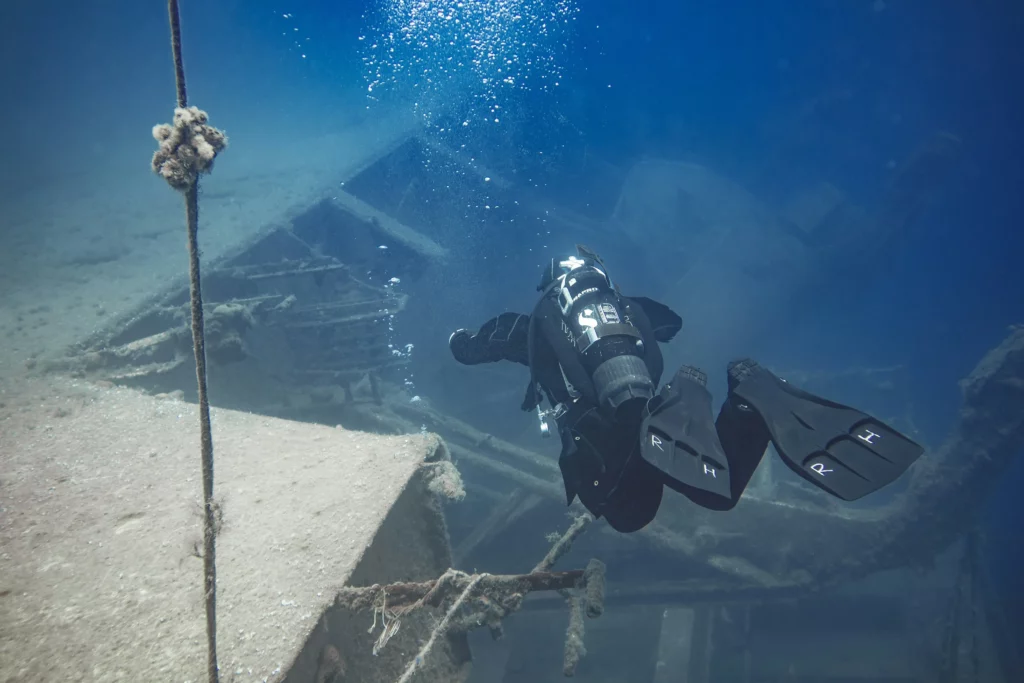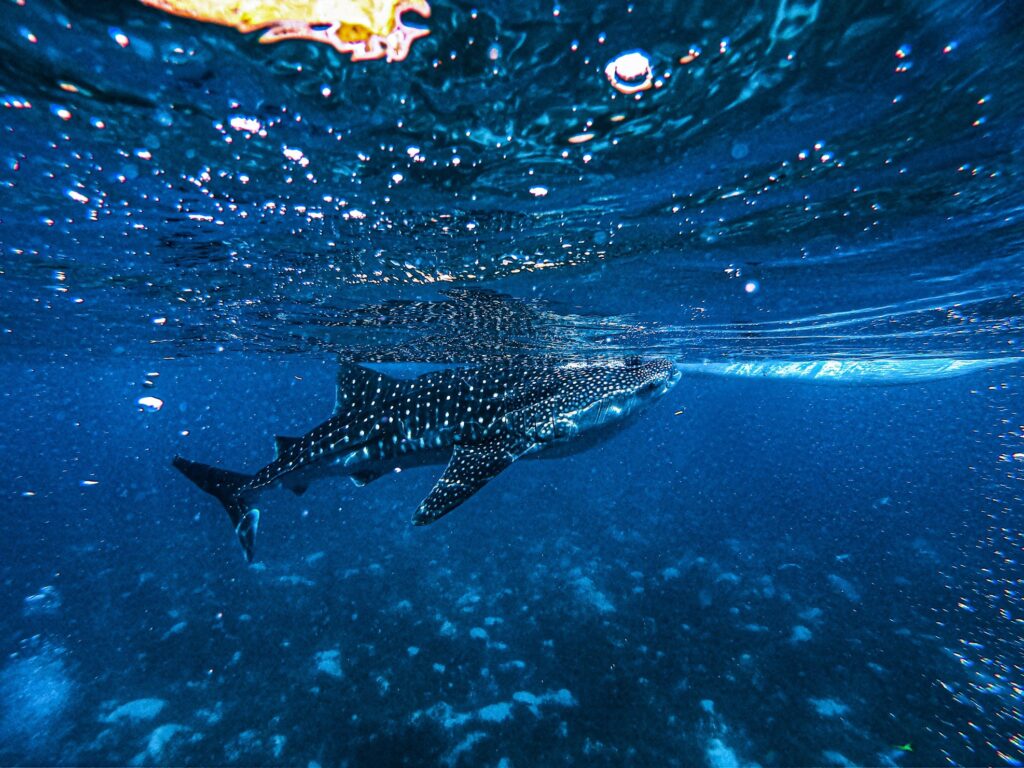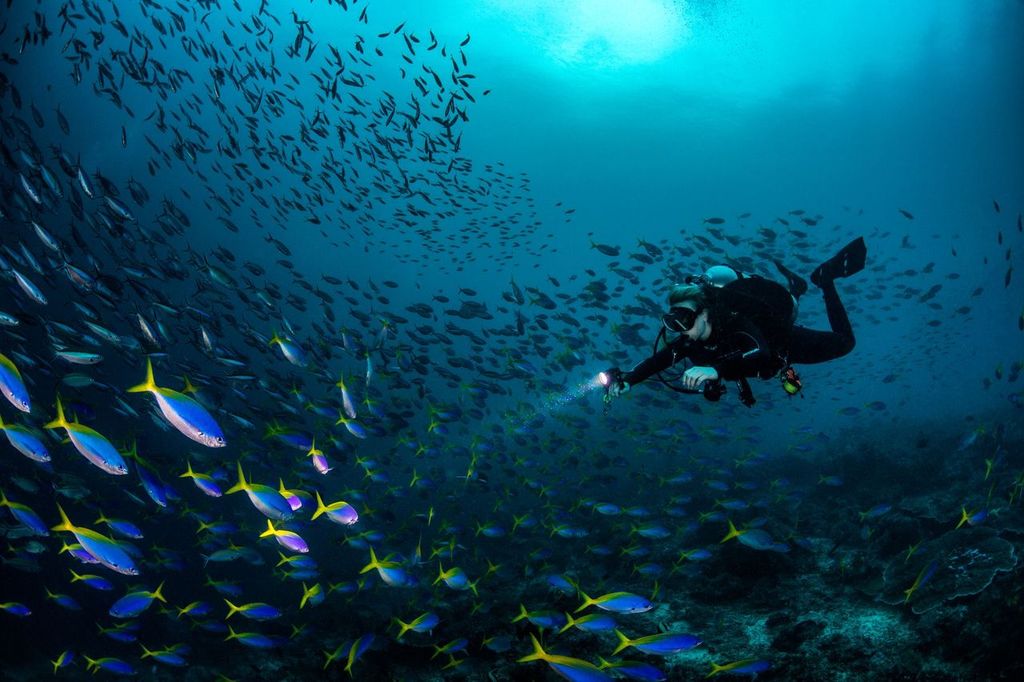Have you ever wondered why the Philippines consistently appears as one of the top recommendations for diving? Think of diving into crystal-clear waters, uncovering wartime wrecks, and swimming among some of the richest marine ecosystems, all in one island nation. There’s bound to be something for everyone in the Philippines’ underwater paradise, promising a mesmerizing experience for divers of every level.
Let’s dive in and discover all about diving in the Philippines before you plan your next trip!
Where is the Philippines Located?

Located in Southeast Asia, the Philippines is an expansive archipelago on the western edge of the Pacific Ocean. It is sandwiched between three seas: the Philippine Sea to the east (part of the Western Pacific Ocean), the South China Sea to the west and north, and the Celebes Sea to the south. The convergence of these three sea currents created marine environments that help fuel the incredible biodiversity beneath its waves, making it a dream destination for many.
As part of the Pacific Ring of Fire, the country is characterized by volcanic origins, resulting in a mountainous landscape with an incredibly long coastline fringed by extensive coral reef systems. The main island is broadly categorized into three major island groups: Luzon to the north, the Visayas in the central region, and Mindanao further south. Each has its unique local specialties, weather, and dive resorts.
Why is the Philippines Considered a Top Diving Destination?
The Philippines’ reputation is firmly rooted in its extraordinary marine biodiversity and the sheer variety of underwater experiences it offers. The key factor is its location at the heart of the Coral Triangle, which is recognized as the global epicenter of marine biodiversity and home to an astonishing 37% of the world’s fish species.
Moreover, the underwater topography there is as varied as the marine life. The seascape is full of surprises, from dramatic submarine cliffs adorned with vibrant corals to intricate coralline walls teeming with activity. Add to that the historically significant World War II shipwrecks, particularly in areas like Coron, which offers a haunting yet fascinating glimpse into the past.
Furthermore, the region’s consistently warm waters, gorgeous tropical landscapes, and the renowned local hospitality (including from our dive staff at Solitude One!) come together to give you some of the most unforgettable diving experiences in the world.
Best Time to Scuba Dive in the Philippines
Any time of the year works well with the Philippines’ climate and temperature. However, for first-time divers, we suggest visiting during the dry season, which runs from November to May, and experience the calm waves with better visibility. However, if you’re looking for a new challenge, you’re welcome to visit at any time!
Just a heads-up, some spots like Palawan might be off the cards for diving during the rainy season from late June to October. Many liveaboard sites take a seasonal break around this period, so it’s always good to check ahead when planning your underwater adventures.
Top 5 Diving Spots in the Philippines
With many popular diving destinations in the Philippines, you might wonder which spot you should visit first. With that in mind, we have curated our list of the best dive sites in the Philippines, arranged from beginner-friendly spots to more advanced sites:
1. Moalboal, Cebu

Moalboal, Cebu, is a fantastic spot for first-time and seasoned divers alike. Whether taking your first plunge or snorkeling, the experience is nothing short of magical.
This laid-back coastal town is best known for the mesmerizing Sardine Run, where millions of sardines move in unison in a breathtaking underwater display. Even better, you don’t need scuba gear to witness it—just a mask and snorkel will do the trick.
Add to that the friendly local vibe, beautiful coral gardens, and postcard-worthy sunsets, and it’s easy to see why Moalboal continues to win the hearts of divers and ocean lovers worldwide.
2. Anilao, Batangas

Just a two-hour drive from Manila, Anilao is a favorite among divers worldwide due to its rich marine life and unique underwater experiences.
Anilao is particularly well-known for muck diving, where divers explore sandy seabeds to look for camouflaged critters like frogfish and seahorses. This also makes it a haven for macro photography lovers, who often come to capture stunning close-ups of these species. For something more surreal, blackwater diving offers a chance to drift in the open ocean at night, surrounded by glowing plankton and strange deep-sea creatures.
If you’re new to diving, worry not. Anilao’s typically calm currents make it easy and welcoming to kickstart your underwater adventures confidently.
3. Coron Bay, Palawan

Into wreck diving? We’ve got you. Coron Bay in Palawan is a dream come true for underwater explorers. Once a strategic Japanese harbor during World War II, the bay is now home to a hauntingly beautiful collection of sunken warships. Over the years, these wrecks have transformed into artificial reefs, attracting an abundance of marine life that find shelter and food among the rusted hulls.
As you glide through these submerged relics, you might spot schools of batfish weaving between the beams, vibrant nudibranchs clinging to the metal surfaces, or even turtles cruising by. Soft corals, sponges, and sea fans have also made the wrecks their home, turning history into a vibrant, living reef.
The best part? Many of the wrecks are at relatively shallow depths, with calm conditions and good visibility, making them the perfect introduction to one of the most unique diving experiences the Philippines has to offer.
4. Tubbataha Reefs, Palawan

Tubbataha Reefs Natural Park is often hailed as the crown jewel of Philippine diving, with many seasoned divers considering this UNESCO World Heritage Site the pinnacle of their underwater adventures.
Located in the middle of the Sulu Sea, Tubbataha is a remote marine sanctuary that overflows with life. In addition to unique species like manta rays and green turtles, it’s also home to over 600 species of fish and 360 species of coral, nearly half of all known coral species worldwide.
Because of its protected status and isolated location, Tubbataha can only be accessed by liveaboards that operate exclusively from mid-March to mid-June. During this period, divers can enjoy calm seas and exceptional visibility, making it the ideal time to explore this UNESCO World Heritage Site.
5. Malapascua Island, Cebu

Malapascua Island is your go-to place if you are looking for Thresher Sharks. These sleek, long-tailed sharks usually prefer the depths, making encounters elsewhere quite rare. But at Malapascua’s Monad Shoal, they rise early each morning from the deep to visit special cleaning stations, where small reef fish tidy them up by nibbling off parasites.
While the experience is unforgettable, it’s worth noting that Malapascua is better suited for more experienced divers. The dive sites are deeper than most beginner-friendly spots, and currents can be stronger too.
That said, those with some experience will find this island an absolute gem not just for the thrashers but also for encounters with manta rays, devil rays, and all sorts of fascinating macro life.
Marine Life You Can Expect to See While Diving in the Philippines

The Philippines boasts a diverse and astonishing array of marine creatures thanks to its convenient location between three major bodies of water.
Hence, expect to share the underwater space with some of the ocean’s most iconic residents. Gentle whale sharks glide past with calm curiosity, while the elusive thresher sharks make their rare, early-morning appearances in places like Malapascua. Graceful manta rays sweep through cleaning stations like underwater dancers, and sea turtles drift serenely over coral gardens as if time itself has slowed down.
Beyond these larger inhabitants, the Philippines is a paradise for macro photography enthusiasts. Its vibrant reefs and mysterious muck sites are brimming with some of the ocean’s most curious creatures. Picture candy-colored nudibranchs, googly-eyed frogfish, flamboyant mandarinfish, and camouflaged pygmy seahorses that are no larger than a grain of rice. You might even spot the mesmerizing blue-ringed octopus flashing its electric warning hues.
What Non-Diving Activities Can You Enjoy in the Philippines?
When visiting the Philippines, the adventures you can enjoy extend far beyond just the diving opportunities. While exploring the underwater marvels is a primary focus, many adventurers enjoy various other activities and on-shore excursions to enrich their experience.
If you embark on a liveaboard ship, they are perfect for sunbathing, reading, or just stargazing, enjoying the panoramic ocean. You can also go island hopping and visit local beaches, enjoying the differences of each island to the fullest. If you prefer to stay closer to the surface or for non-diving companions, you can also try snorkeling! Apo Island, for instance, is renowned for its world-class snorkeling.
How Do You Plan a Scuba Diving Trip to the Philippines?

There are some things to remember when planning a scuba diving trip to this diverse archipelago, from choosing the right accommodation type to understanding certification requirements and various local travel tips. A little preparation goes a long way to ensure an unforgettable experience.
Pick the Right Accommodations
The Philippines offers two primary styles of accommodation for divers: land-based dive resorts and dedicated liveaboard vessels. Each has its own pros and cons, so you can choose one based on your trip goal.
- Dive Resorts usually provide spacious rooms, a wider range of experiences such as swimming pools, and the stability of being on land, which is better if you are prone to having sea sickness. However, with resorts, travel time from land by boat can sometimes cut into your relaxation time.
- Liveaboards, on the other hand, are purposefully built for immersive diving experiences. Their main advantage is accessing remote and often more pristine dive locations. Additionally, liveaboards allow you to visit multiple islands and dive sites over a single trip without the need to pack and unpack.
Choosing between a resort and a liveaboard is often heavily influenced by your specific dive destinations. Some resorts and liveaboards usually have their own itinerary, such as the Solitude One 15-Day Itinerary. Let the crew handle the planning, and enjoy your vacation!
Choose the Best Dive Spot for Your Experience Level
The Philippines has many sites suitable for everyone, from those taking their first breaths underwater to highly experienced technical diving sites. However, it is recommended that you be aware of the certification requirements to ensure you have fun and are safe.
Generally, a recognized Open Water Diver certification (from agencies like PADI, SSI, NAUI, etc.) is the minimum prerequisite to dive with an accredited operator in the Philippines. Dive operators will invariably ask for proof of certification, so carrying your certification cards is essential.
If it’s been a while since your last dive, consider signing up for a refresher course. It’s a great way to ease back into the water with confidence, brush up on your skills, and make the most of your underwater adventures.
How to Get to the Philippines
You can fly to the Philippines through Manila (MNL) or Cebu (CEB) international airports. Given its archipelagic nature, inter-island travel relies heavily on domestic flights. Remember, when connecting from international to domestic flights, you’ll likely need to collect and re-check your luggage after clearing customs at your port of entry.
More Essential Travel Tips for Visiting the Philippines
The local currency is the Philippine Peso (PHP). While ATMs are in cities, carrying sufficient cash is vital for remote areas as credit card acceptance is limited outside major establishments. Pack light, breathable clothing, swimwear, a basic first-aid kit, reef-safe sunscreen, and essential dive gear, including certification cards. Check our packing list for a complete guide!
How Can You Plan an Eco-Friendly Diving Trip?
When planning an eco-friendly diving trip, you need to consider selecting a dive operator that demonstrates a strong commitment to sustainable practices. Look for operators who are transparent about their environmental policies, such as those with certifications like Green Fins, or those who actively participate in local marine conservation efforts.
When packing, prioritize reef-safe sunscreen and eco-friendly toiletries to avoid introducing harmful chemicals into the marine environment. Bring reusable water bottles, bags, and containers to reduce your reliance on single-use plastics.
Plan Your Next Dive in the Philippines with Solitude One!

Are you itching to dive into the Philippines’ waters? Join us at Solitude World Liveaboards and Resorts, where we combine the joy of exploring the underwater world with the protection of the ocean!
As a world-class, experienced operator, we’re excited to guide you through the wonders of the Philippines. Our liveaboard vessel, Solitude One, will take you on an adventure around the country, with PADI-certified guides onboard to ensure a safe and enjoyable experience. Whether you’re new to diving or just having fun, we will ensure that your underwater excursions are safe, smooth, and memorable.
Book your next adventure in the Philippines with us here!